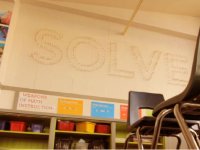Does Your Classroom Tell a Story?
Do you have mystery objects that attract the curiosity of students, leading them to ask questions that foster meaningful conversations? Is your classroom visually stimulating for the students? Does it cultivate creativity, and more importantly, is it filled with objects, images, and even props that help your students learn -- even when they think they're not learning?
Like most teachers, I decorate my classroom with posters and objects that help promote learning, but that also lend a little pizzazz to an otherwise humdrum learning environment. It is typical, for example, for science teachers to have full skeletons and periodic tables in the classrooms, or for history teachers to have maps and portraits of famous historical figures pinned to the walls. However, the best teaching props are the ones that are not so obvious and that help the teacher reach students in unexpected ways.
Why is that Map Upside Down?
One of my favorite classroom props is the "south up map." This map is oriented in a way that many would consider to be upside down in that the southern hemisphere is at the top of the map, and east is to the left. Of course, we know that the earth doesn't have an actual top or bottom, up or down. Students are immediately curious about this map, and more importantly, a teachable moment about history, power, and cultural assumptions can be started in the best way possible -- driven by the curiosity of the student.
Another item that provokes conversation is an art object that I purchased at the museum store that consists of a dollar bill enclosed in a cellophane package and priced at 99 cents. From this one prop, I have had countless conversations about money, value, irony, and yes, contemporary art, with students who casually notice it and ask me about it.
Curiosity and Wonder
In short, you want your classroom to be more than just a visual showroom of your particular subject. Here are some suggestions that will help make your classroom into a palace of curiosity and wonder:
Objects that tell stories: Often, a time or thing that possibly inspired us to love what we teach doesn't necessarily fit into our lesson plans. I keep an old, metal film splicer on my desk. It both teaches students about how film was edited in the days of 16 mm celluloid reels, and reminds me of my days training as a filmmaker. This type of object allows students a different insight into your discipline and also allows you to share a bit of your biography with your students.
Toys: These are great to have in a classroom. Toys that tie into your subject are ideal, and show a sense of play and humor about your subject, but not all toys have to be subject-centered. Some toys like foam balls or fidgets have been shown to help students who are easily distracted concentrate by allowing engage their hands and thus more easily focus their attention. Nostalgic toys can tell something about one's background but also a bit about our cultural history.
Pop culture connections: I have the Inception movie poster on my classroom wall, and while this is not my favorite movie, I noticed when students often mentioned this as their favorite movie. So I chose this movie poster because it allows me to talk about surrealism and the nature of dreams to my art student in a way that that can better understand. Pop-cultural references that are posted in your room also is way for you to connect to the interests of your students so that they see you as a bit more human and aware of the world outside the classroom.
Curiosities and conundrums are always useful. I like old textbooks. I have textbooks over 70 years old that in their photos, language, and exercises reflect the cultural biases of another era. Typewriters, old political posters, and archaic learning tools like slide rulers are also worth having on display. Other objects are interesting just because they have become outmoded. Not surprisingly, for younger generations, this includes many analog technologies like typewriters and turntables.
Change is good so it is wise to periodically change your classroom environment. Simple changes and rearrangements can create an atmosphere that feels fluid and alive -- and never predictable for students.
What are the objects in your classroom that tell a story? Please share in the comments sections below.
